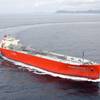Floating Storage at Sea Stalls Despite Falling Oil Prices
- Falling oil prices still to attract large scale storage at sea
- Oil tanker rates gaining ground after years in doldrums
Despite falling oil prices, traders in recent weeks have booked just a few tankers to store cargoes at sea as higher freight costs outweigh any profit play for now.
This is partly due to expectation among tanker owners for higher rates in the final quarter of the year. That means oil traders will have to pay a premium to lease vessels for longer periods as shipping firms remain reluctant to tie up vessels given the potential for quicker earnings.
"Owners will not do storage and miss out on the spot rallies to come," a tanker market source said. "There is not much incentive for owners. Whether it makes sense from the contango side is by the by."
For the first time in several years, the price curve for Brent crude oil futures is now fully in "contango", meaning that every ICE futures month is trading below the subsequent month. This type of futures curve is associated with a bear market where nearby supply overwhelms prompt demand.
Under the right circumstances, this pricing structure can also stimulate an active "cash-and-carry" trade where investors buy oil and store it with the intention of selling it later at a profit.
Unlike in 2009, when a contango led to over 100 million barrels of oil being stored on tankers at sea and sold later, the take-up has been slow this time round.
According to shipping sources and freight bookings, three to four very large crude carriers (VLCCs), each capable of carrying 2 million barrels of oil, have been booked for short-term storage options in recent weeks with little change since September.
The gap between oil contracts for each month needs to be fairly wide in order to pay for this. Such storage plays require investors to pay for storage, financing, insurance as well as the cost of moving oil to and from storage from sellers and then, eventually, to buyers.
At the moment, the cost of storing oil on tankers is anywhere around 90 cents a barrel and the gap between the two front ICE Brent futures contracts is now only 35 cents, making any trade unlikely.
Brent crude fell to a fresh 47-month low on Wednesday before recovering to just above $84 a barrel as faltering global growth curbed demand for fuel at a time of heavy oversupply.
South Africa
While storage on tankers at sea has yet to gather pace, on land there has been more usage, especially at Suldanha Bay in South Africa, which has a large oil storage terminal.
Approximately 21 oil tanker cargoes have been discharged at Saldanha Bay since April, with 13 of those unloading in the past three months alone, according to ThomsonReuters calculations based on vessel flow data.
Another three tankers are now waiting and two more are en route. Altogether, this represents 25 million barrels worth of crude, of which some 6.7 million barrels is still to discharge. No vessels have loaded cargo at the port since then, the data show. Analysts have estimated as much as 30 million barrels in storage at Saldanha Bay, which has a capacity of some 45 million barrels.
After years in the doldrums, due to a glut of ships and soft demand, tanker rates have been strengthening.
"There is an anticipation/hope that this year's winter spike will jump to even higher levels than witnessed last winter and their preference is to stay in the spot market rather than losing out with a fixed rate on short-term time charters," tanker broker E.A. Gibson said in a recent report.
Average earnings for VLCCs on the world's benchmark export route from the Middle East Gulf to Japan have risen this week to nearly $27,000 a day. Earlier this year, they reached their highest level since Feb 2010 at $61,000 a day.
Peter Sand, chief shipping analyst with trade association BIMCO, estimated that VLCC average earnings would stay firm in the final quarter - in the range of $18,500 to $37,500 a day in the period.
"The coming year seems brightest for crude oil tankers, as the pressure from the supply side is low," Sand said.
"This is pivotal to bring about better sentiment, as well as improvements to the fundamental supply-demand balance."
(By Jonathan Saul, Additional reporting by Christopher Johnson in London and Keith Wallis in Singapore, editing by William Hardy)











